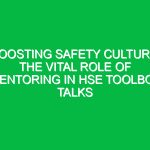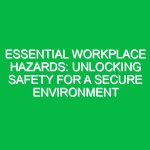Introduction
In the realm of Health, Safety, and Environment (HSE), hazard assessments play a pivotal role in fostering a safe and sustainable workplace. But who is responsible for conducting a hazard assessment? This question is not merely academic; it is a fundamental inquiry that shapes the safety culture of any organization. A hazard assessment involves identifying potential hazards, evaluating risks, and implementing measures to mitigate those risks. It is a proactive approach designed to prevent accidents and injuries, safeguarding not only employees but also the surrounding environment.
Understanding who conducts these assessments is essential for organizations committed to maintaining high safety standards. This article delves deep into the responsibilities associated with conducting hazard assessments, exploring the various roles involved, methodologies employed, and the importance of adhering to regulations and standards. By the end, you will have a comprehensive understanding of this critical aspect of HSE responsibility.
Understanding Hazard Assessments
Before diving into who is responsible for conducting a hazard assessment, it is crucial to define what a hazard assessment entails. A hazard assessment is a systematic process used to identify, evaluate, and control hazards that could potentially harm employees, property, or the environment. This process typically includes:
- Identifying hazards and risks associated with specific tasks or environments.
- Assessing the potential impact of these hazards.
- Implementing control measures to mitigate identified risks.
- Regularly reviewing and updating assessments to reflect any changes in operations or regulations.
The primary goal of a hazard assessment is to create a safer workplace by reducing the likelihood of accidents and ensuring compliance with legal requirements.
Who is Responsible for Conducting a Hazard Assessment?
The responsibility for conducting hazard assessments can vary depending on the organization, industry, and specific legal requirements. However, several key roles are commonly involved in this critical process.
1. Safety Officers and HSE Managers
Safety officers and HSE managers are often at the forefront of conducting hazard assessments. They possess the training and expertise necessary to identify risks and implement effective control measures. These professionals are responsible for developing safety policies, conducting regular audits, and ensuring compliance with local and international safety regulations.
For example, in a manufacturing plant, a safety officer may conduct a hazard assessment to evaluate the risks associated with machinery operation. This includes identifying any potential mechanical failures, evaluating ergonomic risks for workers, and implementing preventive measures such as safety guards and training programs.
2. Supervisors and Team Leaders
Supervisors and team leaders play a crucial role in the hazard assessment process by providing insights specific to their teams and operations. They are often the first line of defense in identifying potential hazards in their work areas.
For instance, a construction site supervisor may notice unsafe practices among workers and report these observations to the HSE manager. Their hands-on experience allows them to assess risks more accurately and contribute valuable information to the overall hazard assessment.
3. Employees
Employees themselves also have a responsibility in the hazard assessment process. Workers are often the most familiar with the hazards they face daily. Encouraging employees to participate in hazard assessments fosters a culture of safety and accountability.
Involving employees can take various forms, such as safety committees, focus groups, or regular feedback sessions. For instance, in a laboratory setting, technicians can provide insights on chemical handling and storage that may not be apparent to external assessors.
4. External Consultants
In some cases, organizations may hire external safety consultants to conduct hazard assessments. These professionals bring a wealth of experience and an objective perspective to the process. They can identify hazards that internal personnel might overlook and recommend industry best practices.
For example, a company planning to implement a new technology might hire a consultant to assess potential hazards associated with that technology, ensuring that all risks are adequately addressed before implementation.
Key Components of a Hazard Assessment
Understanding who conducts hazard assessments is just one part of the equation. Equally important are the components that make up an effective hazard assessment. These include:
1. Hazard Identification
This is the first step in any hazard assessment process. It involves recognizing potential hazards within the workplace. Common methods for identifying hazards include inspections, job safety analyses, and employee feedback.
2. Risk Evaluation
Once hazards are identified, the next step is to evaluate the associated risks. This involves assessing the severity and likelihood of incidents occurring as a result of identified hazards. Tools such as risk matrices can help in this assessment.
3. Control Measures
After evaluating risks, organizations must implement control measures to mitigate them. This can include engineering controls (e.g., safety guards), administrative controls (e.g., training programs), and personal protective equipment (e.g., helmets, gloves).
4. Documentation and Review
Documentation of the hazard assessment process is vital for ensuring accountability and compliance. Organizations should maintain records of identified hazards, risk evaluations, and the control measures implemented. Regular reviews of these assessments are necessary to adapt to changes in the workplace or regulations.
Legal Regulations and Standards
Understanding the legal framework governing hazard assessments is crucial for any organization. Various regulations and standards outline the responsibilities of employers and employees in conducting hazard assessments. Here are some key regulations:
1. Occupational Safety and Health Administration (OSHA)
In the United States, OSHA sets forth regulations requiring employers to provide a safe working environment. This includes conducting hazard assessments to identify and mitigate workplace hazards. Non-compliance can result in significant fines and legal repercussions.
2. Environmental Protection Agency (EPA)
For organizations that impact the environment, the EPA mandates assessments to identify potential environmental hazards. This includes evaluating risks associated with waste management, chemical spills, and emissions.
3. International Standards Organization (ISO)
ISO 45001 is an international standard focusing on occupational health and safety management systems. It emphasizes the need for organizations to identify hazards and risks, ensuring a proactive approach to safety.
Best Practices for Conducting Hazard Assessments
To ensure effective hazard assessments, organizations should adhere to best practices, including:
- Involve a diverse team in the assessment process to capture various perspectives.
- Utilize a systematic approach to identify and evaluate hazards.
- Regularly review and update hazard assessments to reflect changes in operations or regulations.
- Provide training for employees on hazard identification and reporting.
- Document all findings and control measures thoroughly.
Conclusion
Understanding who is responsible for conducting a hazard assessment is vital for fostering a safe and compliant workplace. Safety officers, supervisors, employees, and external consultants all play essential roles in this process. By recognizing their responsibilities and adhering to best practices, organizations can significantly reduce risks and enhance safety culture.
In a world where workplace safety is paramount, effective hazard assessments not only protect employees but also contribute to environmental sustainability. As we move forward, organizations must remain vigilant and proactive in their approach to hazard assessments, ensuring that safety is always a top priority. By doing so, they not only comply with legal standards but also cultivate an environment where everyone feels safe and valued.


